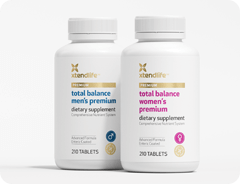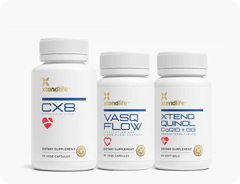It is likely that you are aware that there are many different forms of fat which you knowingly or unwittingly eat every day. You are probably also aware that some types of fat are bad for you and conversely some are good... but, are you sure which ones they are?
If you are not certain and you would like to know, then this newsletter issue is devoted just for you. I will attempt to explain the basic facts that you need to know so that you will not allow 'bad; fats to damage your health and you can use the 'good' fats to enhance it.
You will often find that dietary fats are put into two simplistic categories. One being saturated fats and the other being unsaturated fats. You are told that saturated fats are bad and unsaturated fats are good. But is it as simple as that? No, it's not! Before we look at these closer let us discuss the real 'baddie' fat which is in a category of its own. This is because it is 'man-made'. Maybe we should call this fat the 'ugly' one because it does the most damage.
I'm talking about Transfats or Hydrogenated fats... or, oils
OK, what are they, how are they made and where do I find them?
First of all, you find them almost everywhere. In most processed foods including cookies, solid and semi-solid margarines, commercial cooking oils, and many domestic cooking oils. Look carefully at the labels of any processed food that you buy. If you see hydrogenated or partially hydrogenated on the label, put it back on the shelf.
Hydrogenated fats are produced by taking liquid oil and putting it through a process called hydrogenation. This is a process that combines heat and pressure to add several hydrogen atoms to the oil. This process which takes place at around 400 degrees F for several hours in the presence of a nickel or platinum catalyst converts the liquid to a semi-solid. This helps prevent the oil from becoming rancid even though it destroys its nutritional value. This process enables manufacturers to convert cheap low-quality oils into butter substitutes... hence the explosion of margarines on the market.
These reprocessed oils and fats are completely foreign to the body, and it cannot assimilate them. There is therefore no nutritional value to them at all. Studies have shown that hydrogenated fats and oils are significant contributors to heart disease, cancer, diabetes, immunity, and reproduction problems, as well as obesity. Give them a wide berth!
What about saturated fats?
These are the fats that are found in animal fats, red meat, poultry skin, and dairy products. Also, some vegetable oils such as coconuts and palm oil are high in saturated fat.
These are the fats that the mainstream media warns you to stay away from. This is either through ignorance or influence from their advertisers, or both. There is no doubt that eating saturated fats in excess would not be good for you, but this principle applies to virtually all food.
The simple fact is that your body is designed to cope with saturated fats and has been since the first human walked the earth. Not only are our bodies designed to cope with the ingestion of a certain amount of saturated fats, our bodies also need it. I accept that many people have too high an intake of dietary fat, but it is not usually through this source, but rather from trans or hydrogenated fats.
Saturated fats are natural whose molecules have not been 'bent out of shape'! I'm not kidding… the molecules of transfats are actually distorted into an unnatural configuration.
Cut out all hydrogenated fats and oils and enjoy that juicy steak.
OK, what about the unsaturated fats?
There are two types of unsaturated fats. Poly-unsaturated and mono-unsaturated.
It is generally believed that all unsaturated fats are OK, but this is not the case. Polyunsaturated fats are bad for your health and are consumed in excessive amounts. They should be avoided.
Polyunsaturated fats are found in safflower, corn, sunflower, and soybean vegetable oils. They remain liquid at room temperature. They do not have any redeeming health benefits. They are widely used because they are cheap and although they contain omega-6 essential fatty acids most people get far too much omega-6 which must be partially offset by omega-3 essential fatty acids. More on that shortly!
Switch your polyunsaturated oils to monounsaturated.
The most common sources of mono-unsaturated fats are olive oil, rapeseed oil, hazelnuts, almonds, Brazil nuts, cashews, avocados, sesame seeds, and pumpkin seeds.
Oils made from these foods are much more stable at high temperatures than the poly-unsaturated alternatives, and they do not have the negative health implications. The best oil for cooking is without doubt EXTRA virgin olive oil. I put the 'extra' in caps because it is so important. Most of the mono-unsaturated oils have varying degrees of processing done to them. The more processing, the greater is the loss of the nutrients. The best is cold mechanically pressed oils which are often processed in darkness because of the sensitivity of these oils to light and oxidation.
Studies have shown that a quality cold pressed extra virgin olive oil will help lower the bad LDL cholesterol and raise the good HDL cholesterol. However, ordinary virgin olive oil makes no change.
So, only use quality mono-unsaturated oils for your cooking needs.
Where do omega-3 and omega-6 essential fatty acids fit into all this?
This is another subject all on its own, so I will just try and give you the outline in a nutshell!
As the name suggests Omega-3 and Omega-6 essential fatty acids are just that... they are 'essential'. Many, many ailments can be traced to a shortage of one of these... specifically Omega-3. There are schools of thought which believe the increasing incidence of brain disease is directly attributable to a shortage of omega-3. I think that is credible.
There is no shortage of omega-6 in the typical Western diet. In fact, there is a general overconsumption of this as it is present in most cooking oils. The problem is a deficiency of the Omega-3. The optimum ratio of omega-6 to omega-3 is 3:1. Over the last couple of decades that ratio has gotten out of control and it is now estimated that the ratio is something like 20:1 or maybe even as high as 50:1.
Start adding omega-3 essential fatty acids into your regular diet. The best natural source is flax seeds. Go to your local health food store and buy some ground flax seeds (preferably organic) and sprinkle a heaped tablespoon on your food every day. You can also get omega-3 from oily fishes such as salmon. The problem there though is the difficulty of getting fish which is 100% free of contaminants.
The subject of essential fatty acids is a very important one because they have so many far-reaching health implications. I will devote a newsletter to this subject early in the new year.
As you will not receive your next issue of XTEND-YOUR-LIFE until the 1st of January I would like to now extend to you and your family my very best wishes for the coming festive season. These same wishes are extended to you from all the staff here at Xtendlife Natural Products. It has been a satisfying year for us and I hope that it has been for you. We look forward to the coming year and we will do our best to help provide useful information in your quest for vibrant health.
In good health,


 Supplements
Supplements Superfoods
Superfoods Bundles
Bundles




